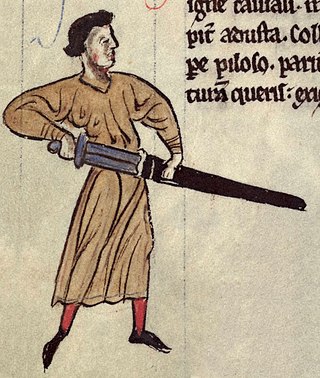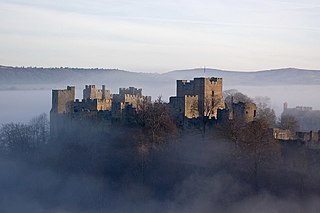

Roger de Lacy [1] (died after 1106) was an Anglo-Norman nobleman, a Marcher Lord on the Welsh border. Roger was a castle builder, particularly at Ludlow Castle.


Roger de Lacy [1] (died after 1106) was an Anglo-Norman nobleman, a Marcher Lord on the Welsh border. Roger was a castle builder, particularly at Ludlow Castle.
From his father, Walter de Lacy, he inherited Castle Frome, Herefordshire. [2] The Domesday Survey (1086) shows Roger holding also Ocle Pychard, [3] Almeley Castle, [4] Eardisley Castle, [5] Icomb Place [6] and Edgeworth Manor. He had an insecure lordship at Ewias Lacy now known as Longtown Castle on the modern day Welsh border., [7] in Longtown, Herefordshire; Stanton Lacy was probably also his after Walter. His main stronghold was Weobley. [8] He held directly from the King. [9] De Lacy also held 1.5 salthouses in Droitwich. [10]
He took part in the rebellion of 1088 against William Rufus, with the other local lords Osbern fitzRichard of Richard's Castle, Ralf of Mortemer, and Bernard of Neufmarche. [11] He was later implicated in the conspiracy of 1095 against William, and was exiled. [12]
Weobley passed to his brother Hugh de Lacy who died before 1115 when the de Lacy lands passed to Pain fitzJohn. Roger's son Gilbert de Lacy spent much effort recovering the Longtown and Ludlow holdings. [13]

Roger Mortimer, 1st Baron Mortimer of Wigmore, of Wigmore Castle in Herefordshire, was a marcher lord who was a loyal ally of King Henry III of England and at times an enemy, at times an ally, of Llywelyn ap Gruffudd, Prince of Wales.
The history of Herefordshire starts with a shire in the time of Athelstan (895–939), and Herefordshire is mentioned in the Anglo-Saxon Chronicle in 1051. The first Anglo-Saxon settlers, the Magonsætan, were a sub-tribal unit of the Hwicce who occupied the Severn valley. The Magonsætan were said to be in the intervening lands between the Rivers Wye and Severn. The undulating hills of marl clay were surrounded by the Welsh mountains to the west; the Malvern Hills to the east; the Clent Hills of the Shropshire borders to the north, and the indeterminate extent of the Forest of Dean to the south. The shire name first recorded in the Anglo-Saxon Chronicle was derived from "Here-ford", Old English for "Army crossing", the location for the city.
Shropshire was established during the division of Saxon Mercia into shires in the 10th century. It is first mentioned in 1006. After the Norman Conquest it experienced significant development, following the granting of the principal estates of the county to eminent Normans, such as Roger De Montgomery and his son Robert de Bellême.
Roger de Breteuil, 2nd Earl of Hereford, succeeded in 1071 to the earldom of Hereford and the English estate of his father, William Fitz-Osbern. He is known to history for his role in the Revolt of the Earls.

de Lacy is the surname of an old Norman family which originated from Lassy, Calvados. The family took part in the Norman Conquest of England and the later Norman invasion of Ireland. The name is first recorded for Hugh de Lacy (1020–1085). His sons, Walter and Ilbert, left Normandy and travelled to England with William the Conqueror. The awards of land by the Conqueror to the de Lacy sons led to two distinct branches of the family: the northern branch, centred on Blackburnshire and west Yorkshire was held by Ilbert's descendants; the southern branch of Marcher Lords, centred on Herefordshire and Shropshire, was held by Walter's descendants.

British Camp is an Iron Age hill fort located at the top of Herefordshire Beacon in the Malvern Hills. The hill fort is protected as a Scheduled Ancient Monument and is owned and maintained by Malvern Hills Conservators. The fort is thought to have been first constructed in the 2nd century BC. A Norman castle was built on the site.
Ranulph I de Mortimer was a Marcher Lord from the Montgomery lands in the Welsh Marches. In England, he was Lord of Wigmore in Herefordshire. In Normandy, he was the Seigneur of St. Victor-en-Caux. Ranulph was the founder of the English House of Mortimer of Wigmore. He acquired Wigmore Castle after William Fitz Osbern's son Roger de Breteuil joined the Revolt of the Earls of 1075. His lands and holdings in Herefordshire and Shropshire were granted to him by William the Conqueror before 1086.

Ewyas Harold Castle was a castle in the village of Ewyas Harold in Herefordshire, England.

Bernard de Neufmarché, also Bernard of Newmarket or Bernard of Newmarch was the first of the Norman conquerors of Wales. He was a minor Norman lord who rose to power in the Welsh Marches before successfully undertaking the invasion and conquest of the Kingdom of Brycheiniog between 1088 and 1095. Out of the ruins of the Welsh kingdom he created the Anglo-Norman lordship of Brecon.
Walter de Clifford (1113–1190) was an Anglo-Norman Marcher Lord of Bronllys Castle on the Welsh border, and was feudal baron of Clifford, seated at Clifford Castle in Herefordshire.

Hugh de Lacy, Lord of Meath, 4th Baron Lacy, was an Anglo-Norman landowner and royal office-holder. He had substantial land holdings in Herefordshire and Shropshire. Following his participation in the Norman Invasion of Ireland, he was granted, in 1172, the lands of the Kingdom of Meath by the Anglo-Norman King Henry II, but he had to gain control of them. The Lordship of Meath was then the most extensive liberty in Ireland.

Walter de Lacy was lord of Meath in Ireland. He was also a substantial land owner in Weobley, Herefordshire, in Ludlow, Shropshire, in Ewyas Lacy in the Welsh Marches, and several lands in Normandy. He was the eldest son of Hugh de Lacy, a leading Cambro-Norman baron in the Norman invasion of Ireland, and Rohese of Monmouth.
Stapleton is a small village and civil parish in Herefordshire near the border town of Presteigne in Wales. The parish borders on Willey, Kinsham and Presteigne. Stapleton is surrounded by farmland. Bryan's Ground gardens are open to the public.

Walter de Clifford was a Welsh Marcher Lord, feudal baron of Clifford of Clifford Castle in Herefordshire and High Sheriff in England.
Ewyas was a possible early Welsh kingdom which may have been formed around the time of the Roman withdrawal from Britain in the 5th century. The name was later used for a much smaller commote or administrative sub-division, which covered the area of the modern Vale of Ewyas and a larger area to the east including the villages of Ewyas Harold and Ewyas Lacy.

Gilbert de Lacy was a medieval Anglo-Norman baron in England, the grandson of Walter de Lacy who died in 1085. Gilbert's father forfeited his English lands in 1096, and Gilbert initially only inherited the lands in Normandy. The younger de Lacy spent much of his life trying to recover his father's English lands, and eventually succeeded. Around 1158, de Lacy became a Templar and went to the Holy Land, where he was one of the commanders against Nur ad-Din in the early 1160s. He died after 1163.

Pain fitzJohn was an Anglo-Norman nobleman and administrator, one of King Henry I of England's "new men", who owed their positions and wealth to the king.

Walter de Lacy was a Norman nobleman who went to England after the Norman Conquest of England in 1066. He received lands in Herefordshire and Shropshire, and served King William I of England by leading military forces during 1075. He died in 1085 and one son inherited his lands. Another son became an abbot.
William Devereux was an Anglo-Norman nobleman living during the reigns of kings William I, William II, and Henry I of England. The Devereux, along with the Baskervilles and Pichards, were prominent knightly families along the Welsh marches at the beginning of the twelfth century, and linked to the Braose and Lacy lordships of the region. William Devereux's descendants would later give rise to the Devereux family of Hereford, and the Devereux Viscounts of Hereford and Earls of Essex.
Sybil was an Anglo-Norman noblewoman in 12th-century England. Her parentage is unclear, but her first marriage to Pain fitzJohn is well attested. Through her marriage, Sybil transferred lands in several shires to her husband, including lands around Ludlow Castle and the castle itself. After Pain's death in 1137, Sybil attempted to retain control of Ludlow and her lands but in 1139 King Stephen of England married her to Josce de Dinan, who died in 1166. Sybil had two daughters with Pain, and is probably the mother of Josce's two daughters also. Sybil's marriage to Josce, and his control of Ludlow in right of his wife forms the background to a medieval Welsh romance, Fouke le Fitz Waryn.